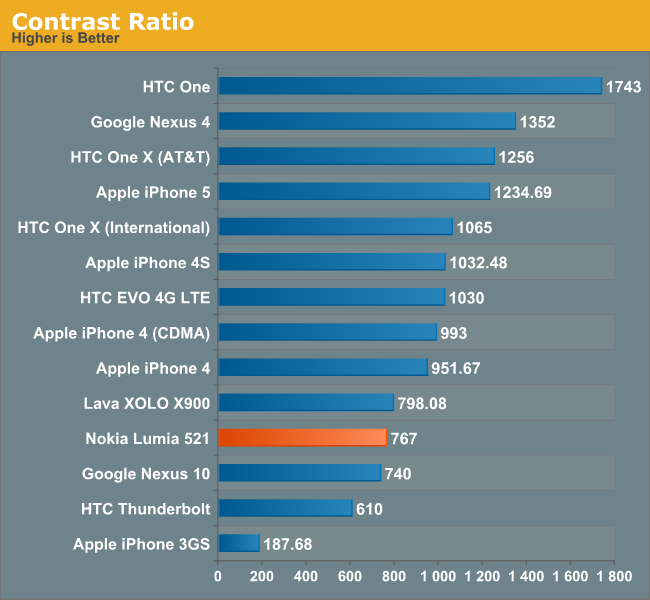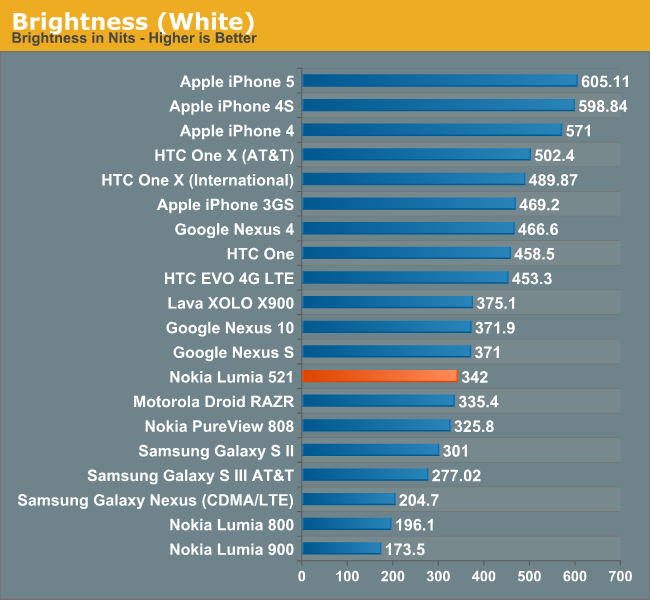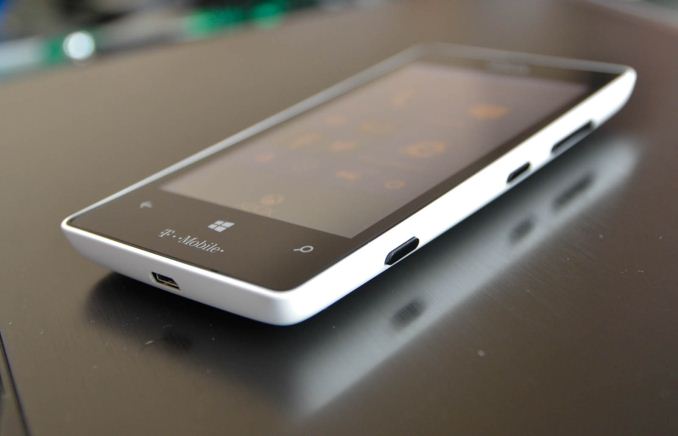Nokia Lumia 521: Quality Smartphone on an Extreme Budget
by Vivek Gowri on August 8, 2013 1:08 AM EST- Posted in
- Smartphones
- Nokia
- Mobile
- windows phone 8
- Lumia 520
- Lumia 521
I was surprised to see that the 521 (and 520) had an IPS display when the specs were finalized, because I fully expected the display to be one of the biggest sacrifices made for the sake of the budget. I suppose it’s not too much of a surprise, given that the 620 has quite a good display.
In person, the 521 display is pretty middling. It’s not a bad panel, but it’s not that fantastic either. Maximum brightness isn’t that great at 342 nits—that’s decent enough for most situations though not quite bright enough for comfortable viewing in broad daylight. The black levels aren’t anything to write home about either, so contrast ratio is pretty low by the standards of the phones we typically look at, though its worth pointing out that we focus primarily on far higher end smartphone hardware. Compared to a contrast ratio chart from a couple of years ago, the 521 is about average. The white point of 6336K is very close to neutral, and color reproduction is pretty solid as well.


 What kind of kills the 521 display experience though isn’t the panel itself, since that’s pretty decent; it’s the gap between the LCD and the glass. That turns what would be a very respectable viewing experience into an ultra reflective mess anytime you venture outdoors. As a result, you end up wanting to crank the display brightness higher than normal (which is why I rarely used the automatic brightness setting). The extra glare brought on by the air gap is rather distracting and ends up being quite the downer in a lot more usage scenarios than just outdoor. In office-style overhead lighting, too, the glare can be quite terrible and generally ends up degrading display quality by a noticeable amount.
What kind of kills the 521 display experience though isn’t the panel itself, since that’s pretty decent; it’s the gap between the LCD and the glass. That turns what would be a very respectable viewing experience into an ultra reflective mess anytime you venture outdoors. As a result, you end up wanting to crank the display brightness higher than normal (which is why I rarely used the automatic brightness setting). The extra glare brought on by the air gap is rather distracting and ends up being quite the downer in a lot more usage scenarios than just outdoor. In office-style overhead lighting, too, the glare can be quite terrible and generally ends up degrading display quality by a noticeable amount.
 Given the price point, it’s hard to fault the 521 too much and I must admit that I have somewhat of a skewed perspective. When you’re used to carrying a One, an S4, or another device with a screen of that caliber, the step down to a far lower quality WVGA panel seems pretty drastic. But the colors are vibrant, viewing angles are predictably stellar, and overall the panel looks pretty good, so there are a lot of positives to focus on.
Given the price point, it’s hard to fault the 521 too much and I must admit that I have somewhat of a skewed perspective. When you’re used to carrying a One, an S4, or another device with a screen of that caliber, the step down to a far lower quality WVGA panel seems pretty drastic. But the colors are vibrant, viewing angles are predictably stellar, and overall the panel looks pretty good, so there are a lot of positives to focus on.
The brightness controls for Windows Phone are a bit finicky—you only get four options: low, medium, high, and automatic. The brightness steps are pretty reasonable, starting with low at 74 nits, medium at 191 nits, and high at 342 nits. There is no iOS or Android style brightness slider, so you’re basically stuck trusting the light sensor or one of the three presets.










116 Comments
View All Comments
USGroup1 - Thursday, August 8, 2013 - link
I'm sorry but your browser tests and conclusions are beyond stupid. Your Sunspider test result clearly shows that the slowest Windows phone 8 device has a faster browser than some Android devices with much more powerful SoC."Microsoft clearly optimized for Sunspider, as we’ve seen over the years, and while that lets them stay competitive in that one benchmark, it doesn’t really mean anything as far as having decent or even acceptable browser performance. It’s just sad."
Wow, just wow, so they optimized their browser for Sunspider test to make it look good, lol pity they didn't do it for Google Octane Benchmark right?
MrSpadge - Thursday, August 8, 2013 - link
It's well known tast companies optimize for Sunspider so much that the score doesn't correlate with real world performance any more. Not saying this isn't true for the other benchmarks as well.. but don't weight Sunspider scores too heavily.Maybe Mozilla should port Firefox to Win Phone instead of trying to build an entire new OS?
InsGadget - Thursday, August 8, 2013 - link
In general, web pages work fine on my L920, even full desktop ones. I'd like to see some real-world tests instead of these canned benchmarks, anyways, since they can be easily gamed.Myrandex - Friday, August 9, 2013 - link
I agree my Lumia 920 handles pretty much any website I can throw at it with no issues. The only ones that I have trouble with are ones that are flash based (very rare) or ones not designed for touch screens (which would affect all platforms, such as websites with menus that require you to hover a mouse over...come on realize how popular touch screens are and get rid of that stuff web devs!)Flying Goat - Friday, August 9, 2013 - link
You can't really port Firefox to Win Phone any more than you can to iOS. Microsoft won't let third party browsers use their own JIT Javascript compiler, so would have to be either very slow, or an IE wrapper. They also won't have access to the functionality needed to set up a secure sandbox. See http://blog.mozilla.org/blog/2012/05/09/windows-on...madmilk - Thursday, August 8, 2013 - link
Most JITs are so-called "tracing" JITs -- they optimize at runtime. However, optimization by the JIT is not free, so it only makes sense to do it when there's a real need. Sunspider's tests are so short that browsers often don't bother, resulting in suboptimal scores.This can be hacked around for a significant increase in scores (or the test can be modified -- there's a modified Sunspider test that runs each test 50 times), but Sunspider is so far from a realistic Javascript workload that such a hack would likely cause extra time and power consumption in other tasks. Additionally, Sunspider doesn't do anything to evaluate other parts of the browser like DOM, which very often is the bottleneck in large Javascript applications.
cheshirster - Friday, August 9, 2013 - link
I agree, and that is unexpected on Anandtech. IE on 521 is performing really well in real-world compartions to low and middle price androids.savagemike - Thursday, August 8, 2013 - link
So - could I just pick one of these up on Amazon and use it with an MVNO of AT&T?notposting - Thursday, August 8, 2013 - link
AT&T has the 520 available as a GoPhone, might be a better choice (probably need to check data bands, locking).A5 - Thursday, August 8, 2013 - link
Yeah, the 520 is a better option if you're using an AT&T MVNO. 521 just gets you 21mbps on T-Mo bands.